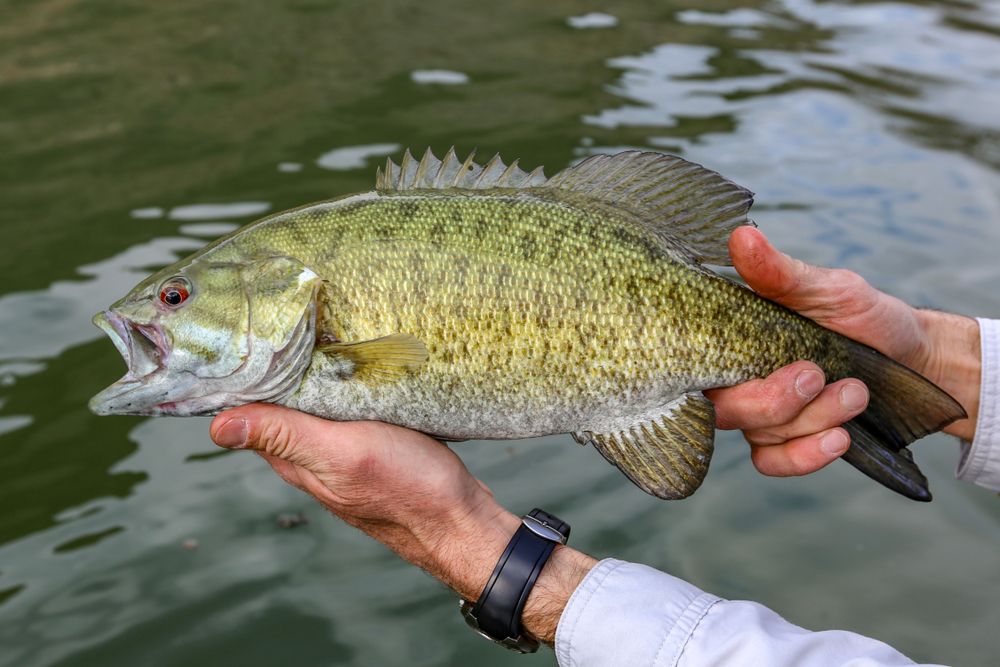Primary Spawn: Late May through June (approximately 2-3 weeks after largemouth bass spawn) when water temperatures reach 60-70°F; optimal spawning occurs at 62-65°F; cooler water preference means later spawn than largemouth; spawn timing varies with latitude and yearly weather patterns
Spawning Habitat: Rocky or gravel areas in 3-10 feet of water (slightly deeper than largemouth); prefer areas with some current or wave action providing oxygenation; clean gravel, rubble, or coarse sand bottom; protection from heavy wind and waves; proximity to deeper water for quick access; less likely to spawn in soft-bottom areas or heavy vegetation; often near boulders, sunken logs, or rocky points
Reproductive Behavior: Pre-spawn (Late April-May): Males move to spawning areas when water reaches 55-60°F; females stage in deeper water 15-25 feet feeding heavily on crayfish and baitfish; excellent fishing for larger females during staging period
Nest Building: Male selects site in rocky or gravel area; fans out circular depression 2-4 feet in diameter using powerful tail sweeps; removes loose debris and silt exposing clean gravel or rock; nest preparation more vigorous than largemouth due to heavier substrate; may take 3-7 days to complete nest; nests often in loose colonies with multiple males nesting in proximity (10-30 feet apart)
Spawning Act: Female approaches nest when ready; male performs courtship display swimming around female; female deposits 5,000-14,000 eggs (smaller clutch than similar-sized largemouth) in clusters across nest bottom; male immediately fertilizes eggs with milt; spawning occurs over several hours; female may spawn with single male or visit multiple nests; larger females produce more eggs (up to 21,000 for trophy fish)
Post-Spawn Male Behavior: Male remains on nest providing intensive parental care; constantly fans eggs with tail and pectoral fins providing oxygen and preventing silt accumulation; guards nest with extreme aggression attacking any intruders regardless of size; will strike lures, other fish, turtles, snakes, human hands/feet approaching nest; does not feed during entire nest-guarding period; fans eggs for 3-5 days until hatching (longer in cooler water); continues guarding fry for additional 2-3 weeks—longer than largemouth; fry form tight black “fry ball” school near nest; male protects fry until they disperse into rocky crevices; males lose 15-25% of body weight during 3-4 week nest defense; extremely vulnerable to fishing pressure during nesting period
Post-Spawn Female Behavior: Females leave nest immediately after egg deposition; move to nearby deeper water 15-30 feet to recover; rest period of 1-2 weeks with minimal feeding; gradually resume normal feeding patterns; move to summer structure (deep rocky ledges, points)
Fry Development: Eggs hatch in 3-5 days depending on water temperature; fry remain in nest depression feeding on yolk sac attached to underside; become free-swimming after 7-10 days; school tightly under male protection forming dense black “fry ball”; after male abandons, fry disperse into rocky crevices and shallow areas; feed on microscopic zooplankton initially; at 1-2 inches begin eating aquatic insect larvae and small crustaceans; at 2-3 inches start consuming small crayfish and fish; rapid growth first year; males reach sexual maturity at 3-4 years (9-12 inches); females mature at 4-5 years (12-14 inches)—slower maturity than largemouth
Nest Site Fidelity: Males often return to same general area or even exact nest site in subsequent years; successful spawning sites used repeatedly; nesting colonies may occupy same locations for decades

